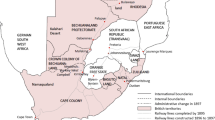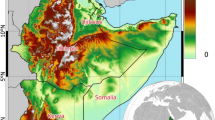Abstract
The Eastern Mediterranean region is among the regions which were predicted to become drier under IPCC climate scenarios. Here, we document a gradual reduction of rainfall and tree growth and the loss of rural springs during the last decades of the twentieth century. Years with severe drought are associated with very low tree growth (dendrochronology) and dry falling of springs as evidenced by interviews with local stakeholders. The paper discusses the consequences of accelerating drought on natural vegetation and agriculture and points at the interaction with fire dynamics and economy, both likely to enhance the drought effect.








Similar content being viewed by others
References
Bolle H-J (ed) (2003) Mediterranean climate. Variability and trends. Springer, Berlin Heildelburg New York
Christodoulakis D, Georgiadis T (1990) The vegetation of the island of Samos, Greece. Ann Musei Goulandris 8:45–80
Cleveland WS (1981) LOWNESS: a program for smoothing scatter plots by robust locally weighted regression. Am Stat 35:54
Gassner G, Christiansen-Weniger F (1942) Dendroklimatologische Untersuchungen über die Jahresringentwicklung der Kiefern in Anatolien. Acta Leopoldina 12:4–137
Georgiadis A (2003) Fire risk in Greece (Dissertation Topic). http://www.uea.ac.uk/~e238104/Fires.htm
Hughes MK, Kuniholm PI, Eischeid JK, Garfin G, Griggs CB, Latini C (2001) Aegean tree-ring signature years explained. Tree-ring Res 57:67–73
IPCC (2002) Climate change and biodiversity. IPCC Technical Paper V. IPCC
JISO (2003) http://www.tao.atmos.washington.edu/main.html
Körner Ch (2003) Carbon limitation in trees. J Ecol 91:4–17
Kuniholm PI (1990) Archaeological evidence and non-evidence for climate change. Phil Trans R Soc Lond A 330:645–655
Larcher W (1972) Der Wasserhaushalt immergruner Pflanzen im Winter. Ber Dt Bot Ges 85:315–327
Lev-Yadun S (2000) Wood structure and the ecology of annual growth ring formation in Pinus halepensis and P. brutia. In: Ne’eman G, Trabaud L (eds) Ecology, biodiversity and management of Pinus halepensis and P. brutia forest ecosystems in the Mediterranean basin. Backhuys, Leiden, pp 67–78
Luterbacher J, Xoplaki E (2003) 500-year winter temperature and precipitation variability over the Mediterranean area and its connection to the large-scale atmospheric circulation. In: Bolle H-J (ed) Mediterranean climate. Variability and trends. Springer, Berlin Heidelburg New York, pp 133–153
Maheras P, Anagnostopoulou C (2003) Circulation types and their influence on the interannual variability and precipitation changes in Greece. In: Bolle H-J (ed) Mediterranean climate. Variability and trends. Springer, Berlin Heidelburg New York pp 215–239
Messeri A (1948) L’evoluzione della cerchia legnosa in pinus halepensis Mill in Bari. Nuovo Giornale Bot Italiano 55:111–132
Ne’eman G, Trabaud L (eds) (2000) Ecology, biogeography and management of Pinus halepensis and P. brutia forest ecosystems in the Mediterranean basin. Backhuys, Leiden
Quézel P (2000) Taxonomy and biogeography of Mediterranean pines (Pinus halepensis and P. brutia). In: Ne’eman G, Trabaud L (eds) Ecology, biogeography and management of Pinus halepensis and P. brutia forest ecosystems in the Mediterranean basin. Backhuys, Leiden, pp 1–12
Rechinger KH (1950) Grundzüge der Pflanzenverbreitung in der Aegäis III. Vegetatio 2:365–386
Schiller G (2000) Ecophysiology of Pinus halepensis Mill. and P. brutia Ten. In: Ne’eman G, Trabaud L (eds) Ecology, biogeography and management of Pinus halepensis and P. brutia forest ecosystems in the Mediterranean basin. Backhuys, Leiden, pp 51–65
Thanos CA, Marcou S, Christodoulakis D, Yannitsaros A (1989) Early post-fire regeneration in Pinus brutia forest ecosystems of Samos island (Greece). Acta Oecol 10:79–94
Touchan R, Garfin GM, Meko DM, Funkhouser G, Erkan N, Hughes MK, Wallin BS (2003) Preliminary reconstructions of spring precipitation in southwestern Turkey from tree-ring width. Int J Climatol 23:157–171
Warren CR, McGrath JF, Adams MA (2001) Water availability and carbon isotope discrimination in conifers. Oecologia 127:476–486
Xoplaki E, Maheras P, Luterbacher J (2001) Variability of climate in meridional Balkans during the periods 1675–1715 and 1780–1830 and its impact on human life. Clim Change 48:581–615
Zavala MA (2000) Aleppo pine stand dynamics in relation to water balance and disturbance: a mechanistic model. In: Ne’eman G, Trabaud L (eds) Ecology, biogeography and management of Pinus halepensis and P. brutia forest ecosystems in the Mediterranean basin. Backhuys, Leiden, pp 153–165
Acknowledgements
The dendro-ecological data shown here are part of an MSc thesis by Dimitrios Sarris. Fabian Meyer (Basel) helped with advice on the dendrological analysis. The stable isotope data were kindly provided by Rolf Siegwolf (PSI, Villingen, Switzerland). Part of the interviews (Ambelos region) became available thanks to Konstantinos Riglis of Marathokampos. The artwork was done by S. Peláez-Riedl. Pascal Niklaus helped with statistics. Financial support by AVEC (integrated Assessment of Vulnerable Ecosystems under global Change, European Commission, EVK2-CT-2001-20010, led by W. Cramer Potsdam) is gratefully acknowledged. This work was presented at the European drought risk conference in Pythagorion (Samos, Greece) in April 2003. Antony Smith (Staffs, UK), was so kind to check our English during an early drafting stage. The text profited a lot from two anonymous referees’ input. During publication, D.S. was supported by the Research Committee of the University of Patras.
Author information
Authors and Affiliations
Corresponding author
Rights and permissions
About this article
Cite this article
Körner, C., Sarris, D. & Christodoulakis, D. Long-term increase in climatic dryness in the East-Mediterranean as evidenced for the island of Samos. Reg Environ Change 5, 27–36 (2005). https://doi.org/10.1007/s10113-004-0091-x
Received:
Accepted:
Published:
Issue Date:
DOI: https://doi.org/10.1007/s10113-004-0091-x




